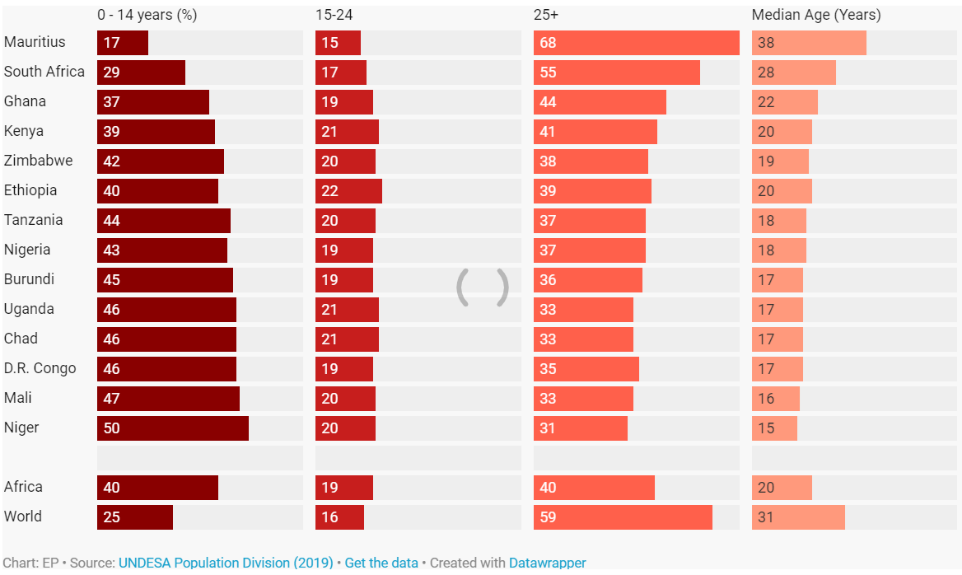Expanding Access To Quality Technical And Vocational Education And Training In Africa: Lessons From Benin

This is the 31st post in a blog series to be published in 2022 by the Secretariat on behalf of the AU High-Level Panel on Emerging Technologies (APET) and the Calestous Juma Executive Dialogues (CJED)
In 2022, Africa's population stands at 1.4 billion; by 2050, that number is expected to double. AU Member States currently have a median age of 20 years, with Niger having the youngest median age at 15 years and Mauritius having the oldest median age at 38 years (Figure 1). African youth aged 15 and 24 represent approximately 20% of the African population.[1] However, over 40% of these youth remain unemployed.[2]
The International Labour Organization (ILO) estimates that young people are now three times more likely than adults to be unemployed.[3] The growing youth population in Africa implies that the demand for jobs will exponentially increase over time.[4] This implies that for Africa's youthful population, many are barely realising promising employment prospects consisting of adequate remuneration and benefits. School, college and university graduates, as well as early school leavers, are all challenged by the current minimal employment opportunities for job seekers.[5]

Figure 1: Median Age of Select AU Member States
To transform Africa's economic capacities, it is necessary to enhance the value-addition of the commodities and natural resources available across the continent. However, this requires highly qualified technical and vocational skills. With these employment challenges, AU Member States could consider alternative skills development strategies to support Africa's youth and equally transform economies. This can involve enhancing vocational and technical skills through Technical and Vocational Education and Training (TVET) programmes to strengthen entrepreneurship and job creation.[6] Entrepreneurship can potentially enhance job creation and reduce unemployment, especially youth employment in Africa.
In response, the African Union developed the Continental Technical and Vocational Education and Training(TVET) strategy to bolster job creation and employment opportunities. Embedded in this strategy, the TVET programme is recognised as the most practical avenue for acquiring readily employable skills suitable for job creation and employment opportunities. Worth noting is that the TVET programme is a comprehensive, multidisciplinary, and practical field of study that can help youth acquire essential skills for manufacturing, agriculture, infrastructure, and many economic activities. TVET aims to provide the necessary vocational and technical literacy skills to enhance the youth's relevance and usefulness in society.[7]
African Union(AU) Member States are encouraged to consider developing TVET skills as they are essential for socio-economic development. These skills would contribute to strengthening economic areas such as the construction and building industry, power and energy generation plants, water management and sanitation systems, and other forms of public works such as carpentry, technicians, and many more.
Benin is one of the AU Member States that are revamping the country's TVET education system. Benin has begun to reform the country's TVET training by strengthening the capacity of TVET training and enhancing enrolment rates within these institutions by 2030.[8] This is part of the government's goal to strengthen economic growth and invest in the people of Benin. The emphasis on skills development, particularly TVET skills, has enabled the Benin government to implement expansive and complex strategies to enhance vocational education.[9] Accordingly, the Strategie Nationale de l'Enseignement et la Formation Techniques et Professionnels (EFTP) (2019-2025) was created in alignment with the Comprehensive Plan National de Développement (2018-2025).[10]
Within this plan, Benin is addressing the high unemployment rates among educated youth[11]. It has established 90 technical high schools and enhanced TVET teacher training and is also strategically increasing the number of secondary students enrolled in technical institutions from approximately 27 thousand in 2018 to 200 thousand by 2025. [12] Furthermore, Benin has also changed its technical and vocational training system to meet the demands of skilled workers through a dual apprenticeship system, which alternates between theoretical schooling with actual apprenticeship training.[13]
The African Union High-Level Panel on Emerging Technologies (APET) challenges AU Member States to enhance their TVET training and skills development programmes through well-structured TVET policy frameworks. APET recognises that Africa's TVET skills development should be strengthened to transform the continent's socio-economic development and growth. Thus, APET strongly encourages AU Member States to invest substantially in TVET education to enable technological advancement, rapid industrialisation, economic development, and poverty alleviation. African governments should also devote adequate resources towards modernising TVET's teaching and learning facilities and continual teacher professional development.
APET urges African governments to institute incentives such as taxation policies and regimes to motivate industrial participation and promote the absorption of TVET skills through various internships. This can enable the private sector enterprises to provide experiential learning internships and training equipment support to TVET institutions. APET further proposes that African governments should actively stimulate local and home-grown production of goods and services to enhance the value addition to primary commodities. Such measures can discourage overreliance on the importation of goods at the expense of the domestic market and manufacturing. This can also strengthen the local manufacturing capacity and enhance the impact of TVET development and uptake of technical and vocational skills.
Since most of Africa's economy remains a prevalently informal economy with a highly volatile labour market, there is a persistent mismatch between the available skills and the needs of the economy.[14] This is a significant obstacle to employment and job growth as the employability issue is impeding at least one hundred million youth from entering the labour market by 2030 due to demographic escalation.[15] Because of its focus on the workplace and employability skills development, TVET is well-positioned to address issues such as skill mismatch.[16]
APET emphasises that existing national TVET systems should be continually transformed to enhance agility. There are existing initiatives that support this continuous transformation approach. For example, through its Platform of Expertise in Vocational Training (PEFOP), the IIEP-UNESCO Dakar Institute supports AU Member States by taking advantage of field experiences and good practices in this sector. The West African Economic and Monetary Union (UEMOA), including countries such as Benin, Burkina Faso, Côte d'Ivoire, Guinea-Bissau, Mali, Niger, Senegal, and Togo, is also sharing resources and tools to enhance their professional integration of the youth and TVET skills. Notably, since 2017, the Ministries of these countries responsible for vocational training have been undertaking experience-sharing of their TVET curricula programmes and professional reference frameworks.[17] Fundamentally, this experience-sharing enables each country to learn and adapt the programmes as per their national needs. Such efforts provide these AU Member States with pedagogical content to enhance TVET management and governance mechanisms.
The IIEP-UNESCO Dakar Platform has created the Mutualisation of Vocational Training Tools and Resources web portal, written in French only. APET suggests that these countries can additionally utilise vocal and local languages to enhance their training programmes. Additionally, APET encourages regional approaches to planning, managing, and implementing TVET in Africa. The UEMOA regional pooling platform is a perfect example of strengthening vocational education, training provision, and systems as a strategic response to youth unemployment.
In March 2021, the African Union, in partnership with UNESCO, launched the Pan-African Initiative for the Digital Transformation of TVET and Skills Development Systems in Africa. Through various complementary actions, including forming national networks and a pan-African training programme, this initiative equips stakeholders within the TVET sector to foster a digital shift. Furthermore, to manage TVET, AU Member States are monitoring the good practices initiated by public and private actors to strengthen the management of TVET policies and institutions.
Public funding across most AU Member States cannot sufficiently meet growing demand due to the critical and worsening financial austerity. For example, Africa has allocated approximately 0.78% of its gross domestic product (GDP) of public investment in post-school education, accounting for approximately 20% of its current public expenditure, between 1993 and 2010.[18] This has grown slightly to 3.4% in 2020.[19] However, during the same period, TVET students grew from 2.7 million in 1991 to 9.3 million in 2006.[20] The enrolments have grown at an average annual rate of 16 % during this period, whilst the public resources allocated to the post-school expenditure have been growing at an average of 6 % per annum.[21] Regrettably, reports show that the situation is even more difficult in the poorest AU Member States, as such countries only allocate approximately 0.63 % of their GDP to Higher Education.[22] In the same period, student enrolments have quadrupled, while available public resources have increased by approximately 0.75%. Notably, post-2010, the trend has since worsened for most AU Member States.[23]
APET notes that the decline in public expenditure per student adversely impacts the quality of teaching and learning, research, and scholarship.[24] As such, Africa has experienced a decrease due to austerity and widespread underinvestment by governments, even though tertiary education is valuable towards sustainable socio-economic growth.[25] Under these difficult conditions, TVET funding in many AU Member States is embarked on through a cost-sharing model and, in some cases, characterised by swings and fluctuations per year due to the absence of a sustainable allocation formula. Thus, APET realises that TVET funding has not matched its potential growth, making financial planning and growth modalities difficult. As such, APET advises that TVET colleges should provide skills development training that aligns with the needs of the private and public economic sectors. This can help TVET colleges generate a third-stream income by integrating training with production so the institutions can cover the training costs through the sales of students' projects.
Additionally, within the Southern African Development Community (SADC) region, TVET education exhibit considerable public expenditure commitments ranging from 0.6 % to 13.6 %.[26] Nonetheless, some SADC countries are dedicating limited public expenditure towards TVET education, particularly where there is limited private sector participation and contribution.
Some SADC countries have also instituted levy-grant mechanisms to raise finance from employers. However, this approach varies in generating income ranging from less than US$ 10 million to more than US$ 1 billion per annum.[27] Nevertheless, there are underlying concerns that these levies do not translate into strengthening TVET training programmes, as some employers treat levies as taxation incentives other than sustainable training support. This loophole disadvantages small, micro, and informal enterprises from developing countries as they can barely sustain the levies for their TVET trainees.[28] Furthermore, there is limited evidence supporting the performance of levy-grant systems in the SADC region.[29] However, it seems more likely that there is more private, community and employer investment in TVET in the SADC region than currently captured by the data. Such unavailability of data is impeding a better understanding of the investment patterns that might be useful to policymaking and resource mobilisation into the TVET system.
APET advises AU Member States to undertake systemic reforms by enhancing their qualifications frameworks. On top of developing a national qualifications framework (NQF), there should be efforts and commitments to develop a regional framework. As such, the ambitions of the national frameworks should also articulate their convergence to international qualifications by implementing regional TVET qualifications frameworks. The regional framework can be utilised to maximise labour mobility and undertake regional harmonisation to converge national approaches. Furthermore, the quality assurance systems and practices should be distributed across several agencies. Such measures can assist these quality assurance agencies in focusing on different quality assurance practices such as exit assessment and certification, programme approval and provider quality improvement, and provider accreditation and assessment moderation. Different agencies may sometimes perform similar quality assurance tasks but are in various parts of the TVET sector. The quality assurance systems should also adopt a range of evidence-driven approaches to enhance the developmental approach to quality assurance focusing on capacity building and strengthening.
The management of the policy coherence of TVET institutions should consider the inherently cross-sectoral nature of the system under various private-public sector interfaces. Therefore, robust efforts towards enhancing TVET policy coherence responsibility between ministries should be pursued through sustainable inter-ministerial coordination structures. This can link TVET policy coherence to wider governance reforms by establishing national human resource development structures incorporating a wider range of stakeholders. Furthermore, national governance reform should also be pursued to enable well-coordinated inter-ministerial management, such as the Ministries of Education and Labour, instead of assigning one ministry approach.
In conclusion, APET urges AU Member States to foster TVET programmes to prepare African youth to pursue job creation and enhance employment opportunities. This will address the underachievement challenges and prevailing dropout rates due to skills alignment challenges. Thus, AU Member States should develop robust policies enabling TVET programmes to flourish. Unleashing the potential of TVET will involve strengthening TVET assistance, enhancing youth employment, correcting the impeding elements within the TVET ecosystem, and addressing the gaps.
Featured Bloggers – APET Secretariat
Justina Dugbazah
Barbara Glover
Bhekani Mbuli
Chifundo Kungade
Nhlawulo Shikwambane
[1] https://www.afdb.org/fileadmin/uploads/afdb/Documents/Publications/ADR15_chapter_5.pdf.
[2] https://www.afdb.org/fileadmin/uploads/afdb/Images/high_5s/Job_youth_Africa_Job_youth_Africa.pdf.
[3] https://unevoc.unesco.org/home/Tackling+youth+unemployment+through+TVET
[4] https://www.leadersofafrica.org/analysis/youth-unemployment-dilemma-in-africa-recent-data/
[5] https://www.nepad.org/news/unleashing-potential-of-tvet-africa.
[6] https://au.int/sites/default/files/pressreleases/35308-pr-tvet-english_-_final_2.pdf.
[7] https://academicjournals.org/article/article1380900368_Uwaifo.pdf.
[8] https://www.unesco.org/en/articles/strengthening-technical-and-vocational-education-and-training-benin.
[9] https://openknowledge.worldbank.org/bitstream/handle/10986/37508/P175550028ec1402909345001975530e7ab.pdf?sequence=1.
[10] https://www.mutualisation.ccmefp-uemoa.org/system/files/benin_strategie_nationale_etfp_2019-2025_sept2019.pdf.
[11] https://www.3ieimpact.org/sites/default/files/2022-02/Technical-School-WACIE-RR-brief.pdf.
[12] https://www.mutualisation.ccmefp-uemoa.org/system/files/benin_strategie_nationale_etfp_2019-2025_sept2019.pdf.
[13] https://www.3ieimpact.org/sites/default/files/2022-02/Technical-School-WACIE-RR-brief.pdf.
[14] https://www.ilo.org/wcmsp5/groups/public/@ed_emp/@emp_policy/documents/publication/wcms_127814.pdf.
[15] https://blogs.worldbank.org/jobs/creating-good-jobs-africa-demand-and-supply-side-policies.
[16] https://unevoc.unesco.org/home/Tackling+youth+unemployment+through+TVET
[17] https://pefop.iiep.unesco.org/en/network/actors/west-african-economic-and-monetary-union.
[18] https://www.unicef.org/esa/sites/unicef.org.esa/files/2019-10/UNICEF-Botswana-2019-PER-of-Education.pdf.
[19] https://data.worldbank.org/indicator/SE.XPD.TOTL.GD.ZS?locations=ZG.
[20] https://library.oapen.org/bitstream/id/2ffff4ec-22c7-4efc-9a2a-807686932d3a/640951.pdf.
[21] https://gpseducation.oecd.org/revieweducationpolicies/#!node=41705&filter=all.
[22] https://documents1.worldbank.org/curated/en/497251467990390368/pdf/544410PUB0EPI01BOX0349416B01PUBLIC1.pdf.
[23] https://www.iesalc.unesco.org/en/2020/12/23/understanding-access-to-higher-education-in-the-last-two-decades/.
[24] https://www.oecd.org/education/skills-beyond-school/EDIF%202013--N%C2%B018%20(eng).pdf.
[25] https://unesdoc.unesco.org/ark:/48223/pf0000183667.
[26] https://unesdoc.unesco.org/ark:/48223/pf0000225632.
[27] https://www.ilo.org/wcmsp5/groups/public/---ed_emp/---emp_ent/documents/publication/wcms_753306.pdf.
[28] https://tvetjournal.com/tvet-systems/tvet-levy-funding/.
[29] https://www.ilo.org/actemp/publications/WCMS_754219/lang--en/index.htm.


